Putting into contexts everything before introducing a new topic on assessing students’ learning, the session started with the purposes of assessments. A discussion on traditional and non-traditional assessments was also provided.
Group Work
- Students were asked to think of questions regarding portfolio assessments. On what they want to learn about it. They were also asked to give what they
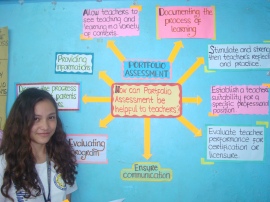 already know about portfolios and portfolio assessments.
already know about portfolios and portfolio assessments. - The questions were written on bond papers and were posted on the wall near their group.
Gallery Walk
- Then students were asked to do a gallery walk. By group, their walk from one set of group postings to another and read the other group’s set of questions regarding portfolio assessments.
- When the group have done the gallery walk and have reached their area, they were asked to mark a star on the questions which they think is unique. The questions will be discussed with the whole group for consideration and evaluation.
Presentation of What Students’ KNOW
- A randomly selected member of the group was asked to present in 1-minute the group discussion output on what they already know about portfolio assessments.
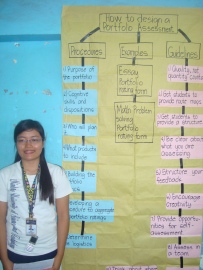 7 Questions: On what they WANT to Know about Portfolio Assessments
7 Questions: On what they WANT to Know about Portfolio Assessments
- The class was asked on the questions which were commonly asked by the groups. These questions were then part of the final 7. The following were the questions commonly asked by the group:
no.1 What is a portfolio? What is NOT a portfolio? What is portfolio assessments? Are there different types of portfolio?
no.2 How are portfolios evaluated? How are rubrics used to evaluate a portfolio?
no.3 What are the advantages and disadvantages of having portfolio assessments?
- The questions marked with STAR which they considered were uniquely asked
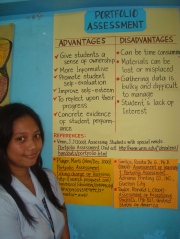 by their group were brought in front and were presented by the group. Clarifications as to what exactly they are asking and what exactly are they looking for were presented so that the group who will be tasked to present the answer to the question by the next class session will be guided.
by their group were brought in front and were presented by the group. Clarifications as to what exactly they are asking and what exactly are they looking for were presented so that the group who will be tasked to present the answer to the question by the next class session will be guided. - Discussion of the final set of questions were facilitated especially on clarifying the kind of answers which the group thinks will be considered sufficient and aligned to the question. Like the students expressed that simply giving the definitions is not enough to answer what a portfolio is.
- The other questions that the group decided to answer for the next session are:
no. 4 Can the portfolio really assess the skills of our students?
no. 5 How should we design portfolio assessments? Are there guidelines for this?
no. 6 How helpful is portfolio assessments for teachers?
no. 7 What do research studies say about using portfolio and employing portfolio
assessments?
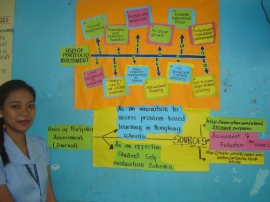 Some Notes During the presentation
Some Notes During the presentation
- Use visual and instructional materials.
- Use keywords and choose an appropriate graphic organizer.
- Include in the presentation your sources: book, journal and internet sources (web address)
The Class Presentation Day
- Before the presentation, the class did a think-pair-share session. They were asked the following questions:
How will Ms Amphie rate your presentation? What will Ms Amphie look for in your presentation?
- So students were asked to THINK individually for 2 minutes of their answers
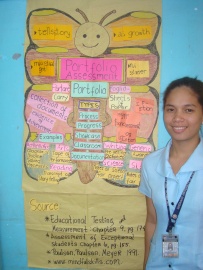 to the above question. Then they were asked to PAIR with a classmate and discuss their answers for 3 minutes. Then they were asked to SHARE their criteria to the group and decide on what to suggest for the whole group discussion.
to the above question. Then they were asked to PAIR with a classmate and discuss their answers for 3 minutes. Then they were asked to SHARE their criteria to the group and decide on what to suggest for the whole group discussion. - Ms Amphie then facilitated the finalization of the criteria to use for evaluating and rating the presentation. The group who suggested a criteria was also asked to explain as to its extent or degree. The following is the common criteria the students presented (across my 4 sections):
completeness, accuracy, sufficiency of answers
creativity: of presentation, of organization, of flow
delivery: able to explain the concepts, clarity of explanation
presentation of credible sources
visual materials: neatness and appropriateness of graphic organizers used
Now, Assessing Learning
Research, readings and presentations on learning portfolio assessments were done. This time, did they really learn? The pre-service will show their skills and application of knowledge by turning in the following:
- Portfolio Assessment Designing (use the template)
- Presentation of WHAT THEY HAVE LEARNED
Below is the template:
This requirement is on Portfolio Assessment Designing. (This means You are to design an assessment process or strategy by asking your students to complete a portfolio.)
Context: Assuming that you are a College Instructor of the field of Specialization that you are taking (this means if you are a SpEd major, assume that you are a SpEd College Instructor). Choose a course/subject in your field of specialization which you think must require a portfolio to assess students’ learning. Then design your assessment using the template below.
Below you will see questions pertaining to designing your portfolio assessment.
You may also read about this from this website: http://www.cse.ucla.edu/products/guidebooks/hightech.pdf
Top of Form
Designing Portfolio Assessment: Teacher Planning Worksheet
Name of GroupMates: ______________
| Introduction: A) Please identify here the course you chose to design a portfolio assessment. B) Tell us the course description, rationale of this course. C)When is this taken by the college students? D) Give us reasons why portfolio is a good assessment tool to determine students’ learning for this course. |
| 1. Set assessment purpose. What aspects of teaching and learning do you want to assess? Why? Who will be involved? |
| 2. Identify instructional outcomes that reflect the assessment purpose. What exactly will you look for? |
| 3. Identify instructional tasks that match the outcomes. Consider current and new tasks and assessment measures. |
| 4. Determine how students will reflect on their work. What self-assessment, goal-setting, and metacognitive tasks will you include? What type of portfolio are you requiring? Can you give a number of sample entries you will be requiring? |
| 5. Decide how you will determine criteria for the portfolio assessment. How will you and your students decide what to include in the portfolio? How will you and your students assess individual pieces of work? What types of rubrics and checklists will you use? Attach rubrics you will use to rate the entries or some entries. |
| 6. Determine the organization and logistics. How will you set up, introduce, and maintain the portfolio project? Where will you store the portfolios? What media will students use? How long will students work on the portfolios? |
| 7. Decide how parents (or other stakeholders) will participate. |
| 8. Identify other areas of concern regarding portfolios and identify resources for answering those questions. |
The questions here are adapted from: http://www.nclrc.org/portfolio/formDesigningPA.html
Notes:
*Please always aim for an excellent paper to submit.
*This is a group work output.
*Deadlines:
SpEd 3×1: Feb 4 2013 (Mon)
SpEd 3×2: Feb 5 2013 (Tue)
SpEd 3×4: Feb 7 2013 (Thu)
SpEd 3×3: Feb 9 2013 (Sat) — drop in my office at Bldg 35.
Thanks for this resource. I’ve added to my list for effective use of e-Portfolios. By any chance do you have links to portfolio examples? Thanks again. http://openingpaths.org/blog/2014/08/20-e-portfolio-resources/